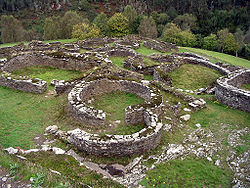Castro culture


Castro culture (Cultura Castreja in Portuguese, Cultura Castrexa in Galician and Cultura castreña in Spanish and Asturian) is the archaeologists' descriptor for the culture of the northwestern part of the Iberian Peninsula (roughly present-day northern Portugal, Galicia and Asturias), from the end of the Bronze Age (9th century BC) until the 1st century AD. The most notable and permanent characteristic of this culture is their walled villages and hill forts, known as castros (from latin castrum: castle). The area of these villages extends as far as the Cares river to the east and to the Douro River in the south.
The area of Ave Valley, in the central area of this culture, had bigger castros, known as Citânias or Cividades (from Latin civitas, city), due to their city-like structure: Citânia de Sanfins, Citânia de Briteiros, Cividade de Bagunte, and Cividade de Terroso.
History
The culture began to develop during the late Bronze Age as a result of strong cultural influence on the indigenous cultures coming from Central Europe and the Atlantic and Mediterranean areas. In the formative period that followed, which lasted until the 5th century BC, the castros extended from south to north and from the coast to the interior of the Iberian Peninsula. The culture continued to expand and develop for about two centuries, until it began to be influenced by the Roman Republic in the 2nd century BC. The culture went through somewhat of a transformation, as a result of the Roman conquest and formation of the Roman province of Gallaecia in the heart of the Castro cultural area, until it finally died out in the 4th Century AD.
Economy

The castro economy was based on many different kinds of agriculture. Some important crops were grains such as wheat and barley, and vegetables such as beans and turnips, among others. Various fruits were also harvested, such as chestnuts. Animals such as cows, horses, sheep, and pigs were raised domestically, while other animals, such as the deer, were hunted. Fish and shellfish, such as hake, were common.
Mining was an integral part of the culture as well. Gold, iron, copper, tin, and lead were the most common ores mined. Castro metallurgy refined the metals from ores and cast them to make various tools. Castro ceramics was also practiced in the region. Castro jewelry has roots from the Bronze Age and was gradually influenced by Central European and Mediterranean cultures. The most characteristic jewelry are bracelets, and pendant-type earrings. Sculpture was practiced more in the south of the region, and increased under Roman rule. Their weapons were mainly swords or dagger-type weapons.
Religion
The religious pantheon was extensive, judging from surviving inscriptions of the Gallo-Roman and Astur era, and definitely included cults and ceremonies to harmonize the people with natural forces. Funerary rites are mostly unknown, for the exception of Cividade de Terroso, where cremation was practiced.
Examples

- Castro de Coaña, Asturias, Spain [es]
- Castro de Baroña, Galicia, Spain
- Castro of Troña, Galicia, Spain
- Castro de Noega-Gijón, Asturias, Spain [es]
- Los Cogotas, Ávila, Spain
- Castro de Ulaca, Spain
- La Mesa De Miranda, Spain
- Numantia, Spain
- Citânia de Sanfins, Paços de Ferreira, Portugal
